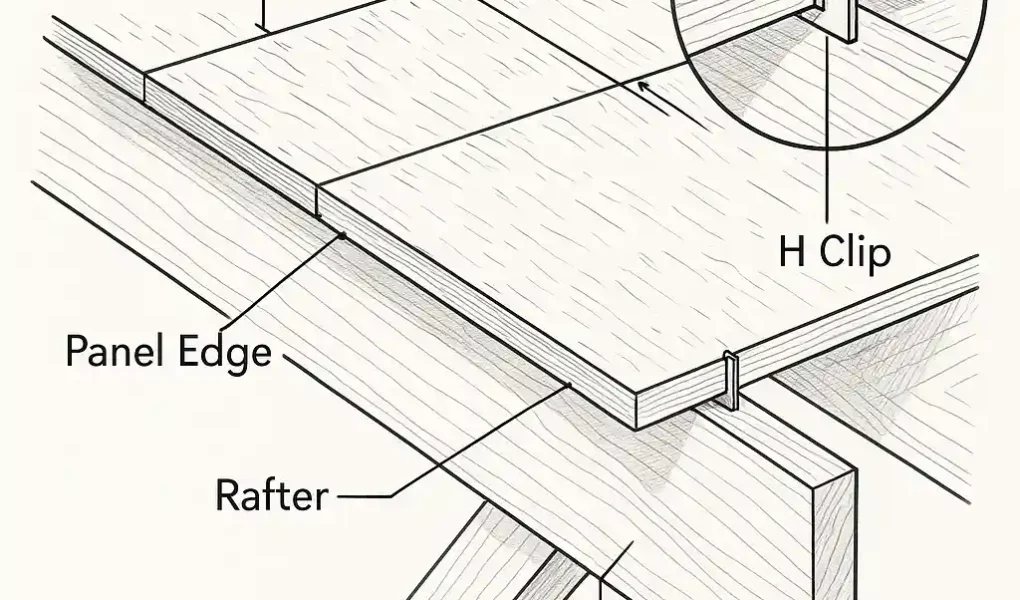Your roof’s structural integrity hinges on the materials and techniques you choose—and 5/8-inch roof sheathing is a common pick for modern homes. But what about those small metal braces called H clips? Are they essential for ensuring your roof stays strong and stable over time?
What Are H Clips?
The Basics of H Clips
H clips (or panel edge clips) are small, H-shaped metal braces used in roofing. They’re typically made of galvanized steel or durable plastic and are designed to connect adjacent sheathing panels. Think of them as tiny bridges that lock plywood or OSB sheets together.
How Do H Clips Work?
These clips snap onto the edges of sheathing panels where they meet over rafters or trusses. Their three main jobs:
- Stabilize panels to prevent sagging or shifting.
- Distribute weight evenly across the roof structure.
- Create gaps for natural wood expansion (to avoid warping).
Why Builders Use Them
Without H clips, roof panels could flex in high winds, leading to premature wear or even leaks. They’re especially useful for thinner sheathing (like 1/2-inch), but their necessity with thicker 5/8-inch panels is debatable.
Understanding 5/8-Inch Roof Sheathing
What Is 5/8 Roof Sheathing?
5/8-inch roof sheathing is a sturdy panel (usually OSB or plywood) that forms the base layer of your roof. At nearly ¾-inch thick, it’s a popular choice for homes in areas prone to heavy snow, wind, or seismic activity.
Strength and Performance Comparison
| Thickness | Best For | Span Rating (Rafter Spacing) |
|---|---|---|
| 1/2-inch | Lightweight roofs | 16-24 inches |
| 5/8-inch | Moderate-heavy loads | 24-48 inches |
| 3/4-inch | Commercial/heavy-duty use | 48+ inches |
- Key Features of 5/8 Sheathing:
- Handles wider rafter spacing (up to 48 inches).
- Resists deflection (bending) better than thinner panels.
- Often meets code requirements for high-wind zones.
Why Choose 5/8-Inch Over Other Thicknesses?
- Cost-Effective Strength: It balances durability and affordability.
- Code Compliance: Many regions mandate 5/8-inch panels for hurricane-prone areas.
- Longevity: Thicker sheathing resists rot and insect damage better than thinner options.
Are H Clips Required for 5/8 Roof Sheathing?
The Short Answer
H clips are NOT always required for 5/8 roof sheathing, but their need hinges on four factors:
- Building Codes: Local regulations may require them.
- Rafter Spacing: Wider spacing (e.g., 24+ inches) often demands H clips.
- Manufacturer Guidelines: Some sheathing brands specify clip usage.
- Environmental Risks: High wind or snow areas may benefit from added support.
Building Code Breakdown
Most U.S. codes (like the IRC 2021) only require H clips if the sheathing is too thin for the span. For example:
- 1/2-inch sheathing over 16-inch rafters: Clips mandatory.
- 5/8-inch sheathing over 24-inch rafters: Clips optional unless specified by the manufacturer.
When to Skip H Clips with 5/8 Sheathing
- If rafter spacing is ≤ 16 inches.
- If the building code defers to manufacturer guidelines that don’t require clips.
- If the roof has additional support (like hurricane straps or adhesive).
Benefits of Using H Clips with 5/8 Roof Sheathing
Enhanced Structural Support
Even for thicker panels, H clips add extra rigidity, which helps:
- Prevent sagging between rafters.
- Resist wind uplift during storms.
- Reduce creaking noises as the house settles.
Cost vs. Longevity Trade-Off
While clips add $0.25–$0.50 per square foot to material costs, they can extend your roof’s lifespan by 5–10 years in harsh climates.
Myth-Busting H Clip Misconceptions
- “They’re Redundant on Thick Sheathing”: False. They add edge support even on 5/8 panels.
- “Nails Alone Are Enough”: True with tight rafter spacing—but not for larger spans.
Potential Downsides and Alternatives to H Clips
Why Some Builders Avoid Them
- Labor-Intensive Installation: Clips take time to snap into place.
- Material Compatibility: Not all sheathing brands work seamlessly with standard clips.
- Moisture Traps: Poorly installed clips can hold water against the wood.
Alternatives to H Clips
| Method | Pros | Cons |
|---|---|---|
| Seam Nails | Cheaper, faster | Less structural support |
| Adhesive | Prevents moisture intrusion | Permanent; hard to repair |
| Tongue-and-Groove Panels | Built-in edge support | More expensive than standard OSB |
Installation Guidelines for H Clips on 5/8 Roof Sheathing
Step-by-Step Process
- Mark Rafter Lines using chalk for alignment.
- Position Clips at panel edges every 12–16 inches.
- Snap Clips onto both panels and rafters.
- Check Gaps to ensure 1/8-inch spacing for expansion.
Pro Tips
- Use stainless steel clips in coastal areas to avoid rust.
- Avoid over-tightening clips—this can crack the sheathing.
Building Code and Manufacturer Standards
IRC Code Requirements
- Section R503.2.3: Sheathing edges must be supported by rafters or clips unless the panel is rated for unsupported spans.
- Always check your local amendments: Florida, for example, mandates clips for all roofs in high-velocity hurricane zones.
Top Sheathing Brand Guidelines
- Georgia-Pacific: Recommends H clips for spans ≥ 24 inches.
- Weyerhaeuser: Requires clips for Edge Gold® panels in snow regions.
Common Mistakes When Using or Omitting H Clips
Errors to Avoid
- Spacing Clips Too Far Apart: Follow the “every other rafter” rule.
- Ignoring Expansion Gaps: No gap = warped sheathing in humid climates.
- Using Damaged Clips: Bent clips won’t secure panels properly.
FAQ
1. Are H clips mandatory for all roof sheathing panels?
No—most codes only require them for spans exceeding the panel’s rating.
2. Can I use 5/8 roof sheathing without H clips safely?
Yes, if local codes and the manufacturer allow it.
3. What happens if H clips are not installed?
Risk of sagging, squeaks, and reduced wind resistance over time.
Conclusion
So, are H clips required for 5/8 roof sheathing? The answer is situational. While not always mandatory, they’re a smart investment for wide spans, harsh climates, or code-heavy regions. When in doubt, consult a local structural engineer—your roof’s durability isn’t worth guessing over!




